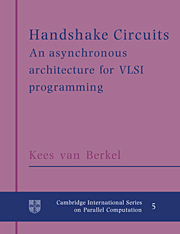Book contents
- Frontmatter
- Contents
- Foreword
- Preface
- 0 Introduction
- 1 Introduction to Tangram and handshake circuits
- 2 Examples of VLSI programs
- 3 Handshake processes
- 4 Handshake circuits
- 5 Sequential handshake processes
- 6 Tangram
- 7 Tangram → handshake circuits
- 8 Handshake circuits → VLSI circuits
- 9 In practice
- A Delay insensitivity
- B Failure semantics
- Bibliography
- Glossary of symbols
- Index
7 - Tangram → handshake circuits
Published online by Cambridge University Press: 14 January 2010
- Frontmatter
- Contents
- Foreword
- Preface
- 0 Introduction
- 1 Introduction to Tangram and handshake circuits
- 2 Examples of VLSI programs
- 3 Handshake processes
- 4 Handshake circuits
- 5 Sequential handshake processes
- 6 Tangram
- 7 Tangram → handshake circuits
- 8 Handshake circuits → VLSI circuits
- 9 In practice
- A Delay insensitivity
- B Failure semantics
- Bibliography
- Glossary of symbols
- Index
Summary
Introduction
The topic of this chapter is the translation of Tangram programs into handshake circuits. Let T be a Tangram program. In Chapter 6 we have defined the meaning of T as the handshake process H-T. The translation to handshake circuits is presented as a mathematical function C, from the set of Tangram programs to the set of handshake circuits. Thus, C-T is a handshake circuit, and handshake process ∥.C.T is the behavior of that circuit. Function C is designed such that
where .P was defined as #[: P] (see Definition 6.7). That is, the translation preserves all the nondeterminism of the program. From a practical viewpoint it is sufficient to realize
in which the behavior of the handshake circuit is a refinement of the handshake behavior of the Tangram program. It may be expected that this relaxed form results in cheaper handshake circuits. The advantage of defining the most nondeterministic handshake circuit of T is that alternative translation functions that synthesize more deterministic circuits can readily be derived from it. Some of these alternatives will be indicated.
Also, we have chosen to translate a Tangram program into the handshake circuit with the most internal parallelism. In particular, all guards of a guarded command are evaluated in parallel, as are the two subexpressions of a binary operation. In general this leads to the fastest implementation, but not necessarily the most area-efficient one. If the VLSI programmer wishes a more sequential handshake circuit he can specify such at the Tangram level.
- Type
- Chapter
- Information
- Handshake CircuitsAn Asynchronous Architecture for VLSI Programming, pp. 123 - 146Publisher: Cambridge University PressPrint publication year: 1994

